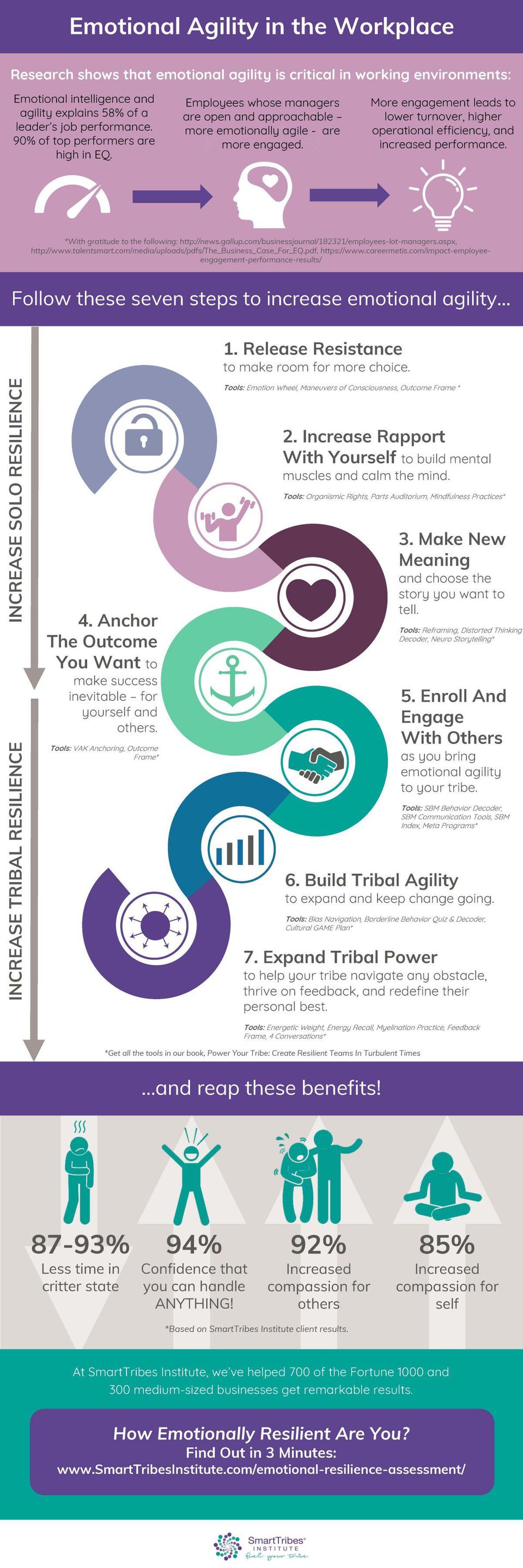
Have you noticed that life is moving at light speed…and it only seems to be getting faster? Have you also noticed that people are more stressed out than ever?
That’s why emotional agility is essential. You need it to navigate turbulent times, keep your sense of humor, and deal with the perpetual uncertainty of your fast paced daily life. No matter what external situations you face, emotional agility is your superpower.
What Is Emotional Agility?
Daniel Goleman’s groundbreaking book, Emotional Intelligence, changed the way we think about human interaction. It ultimately made it okay to acknowledge that humans are emotional beings, even at work. This concept of emotional intelligence is crucial for each of us to understand; lack of it causes the majority of human conflicts, including employee terminations, divorces, and even wars.
However, it’s not enough to simply know that emotional intelligence is important. We have to ask ourselves how we can best shift our emotional state to achieve the outcomes we want, especially when we’re overwhelmed by constant change.
We certainly know it’s not as simple as telling ourselves, “OK, let’s look at this in a positive light.” Nor is it useful to tell someone, “Stop feeling overwhelmed. It’s not helping anybody!”. So what does work? Let’s look at a quick scenario.
A Sales Director Lacking Emotional Agility
Suppose you’re a sales director, and a big client that accounts for 30 percent of your top-line revenue suddenly stops working with you. You know you need to either quickly replace that client, or let go of some staff. Maybe this will mean delaying mission-critical initiatives, and you’ll have to explain those losses to the board. It feels bad, so it is bad. And you, as the sales director, may want to avoid feeling bad at all costs, whether that be via denial, avoidance, freezing up, or resolving (consciously or not) to take your anger and frustration out on your team. All of these responses will likely create an environment of blame rather than collaboration, which is bad enough. However, avoiding your bad feelings comes at a cost too. An opportunity cost.
A Sales Director Utilizing Emotional Agility
A more emotionally agile sales director might still feel bad about losing a big client; it would be strange if she didn’t. But even in her disappointment, this sales director will also have another feeling available to her: inspiration. This feeling of inspiration often comes with the challenges we encounter. Choosing to seize this inspiration, the sales director will behave differently. She will consider it an opportunity to engage with the lost client, and to clarify with specificity why that client left. Rather than using the negative event as a sign of failure, she’ll channel those feelings into a chance to seek feedback, and ultimately as an impetus for growth.
She might redirect her attention to incorporating the feedback gained in order to mobilize her team to plug the holes in the company’s main service offering so that the rest of the client base will benefit and continue to grow. This agile maneuver can result in increased penetration per client, as well as increased top-line revenue per client account.
The factor that made the difference? The meaning that the sales director created from the event–and the feelings that were available to her as a result.
Which of the above examples sounds most familiar?
How can you increase emotional agility for yourself and for your team?
Add this infographic:

The Impact Of Emotional Agility In The Workplace
Our infographic outlines how important emotional agility is in the workplace.
· Emotional intelligence and agility explains 58% of a leader’s job performance
· 90% of top performers are high in EQ
· Employees whose managers are open, approachable and emotionally agile are more engaged
· More engagement leads to lower turnover, higher operational efficiency and increased performance
Want To Increase Emotional Agility? Follow These Seven Steps:
1. Release Resistance: Make room for more choice
2. Increase Rapport With Yourself: Build mental muscles and calm the mind
3. Make New Meaning: Choose the story you want to tell
4. Anchor The Outcome You Want: Make success inevitable for yourself and others
5. Enroll And Engage With Others: Bring emotional agility to your tribe
6. Build Tribal Agility: Expand and keep change going
7. Expand Tribal Power: Help your tribe navigate any obstacle, thrive on feedback and redefine their personal bests
I will be sharing tools, based on the seven steps listed above, that will show you how you and your team can become more emotionally agile. Take a moment to consider the benefits (for you, your company, and your employees) when you’re more emotionally agile.
Here’s what our executive coaching and workshop clients find:
Benefits You Will Reap
· 87-93% less time in Critter State(fight/flight/freeze)
· 94% increased confidence that you can handle anything
· 92% increased compassion for others
· 85% increased compassion for self
The Net-Net
· Emotional agility is critical at work and in life overall
· There are seven proven steps to increase emotional agility
· The tangible benefits that you and your organization will reap are profound
Are you as emotionally agile as you think? Take our 3-minute assessment and find out.
Christine Comaford is a leadership and culture coach who helps businesses achieve growth. Learn more at SmartTribes Institute and see Power Your Tribe: Create Resilient Teams in Turbulent Times and SmartTribes: How Teams Become Brilliant Together.


